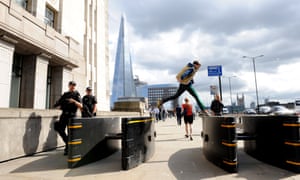Jason Burke
In the last three months, the UK has suffered the most intense surge of terrorist activity for more than a decade. But who has attacked us?
The obvious answer is the Islamic State in Iraq and Syria (Isis). The group has launched a global offensive during the Muslim holy month of Ramadan. As a consequence, there has has been a surge of violence from Nigeria to the Philippines.
In recent weeks, there have also been other attacks elsewhere in the west, though thankfully without serious harm. In Paris, a policeman was bludgeoned with a hammer, and in Melbourne, Australia, a woman was held hostage and killed.
We do not know yet how closely the seven men responsible for these acts of violence were connected to Isis – even though the group has claimed responsibility for all of them.
Salman Abedi, the 23-year-old student who attacked in Manchester, might have been in touch with Isis when in Libya only 10 days before striking. Khaled Massood, who drove a vehicle into pedestrians on Westminster Bridge and then stabbed a policeman to death outside parliament, appears to have been only inspired by the group. The shooting in Melbourne may not have been terrorism at all.
The attacks in the UK involved only five men, as far as we know. With those in Paris and Melbourne, that makes seven. Do they share any characteristics that might help our security services to identify future attackers and avert future tragedy?
At first glance, the answer seems to be yes. All are male, young, immigrants or born of immigrant parents and identify – at least when they commit their attacks – as Muslims. On close examination, however, the picture becomes more complex.
Take the age of the attackers. The youngest was 22-year-old Youssef Zaghba, one of the three men who drove a van into crowds on London Bridge and then stabbed people in bars and restuarants. The oldest was Massood, the Westminster attacker, who was 52. The others were between 23 and 40.
Education? Some of the seven have few or no real qualifications. But Farid Ikken, the man who attacked a policeman at Notre Dame cathedral in Paris, had a masters degree and was studying for a PhD in media at a French university. None were wealthy, but that’s hardly evidence of a link between poverty and extremist violence.
Faith? Ikken, who had lived for a long time in Sweden with a Swedish woman, was described by friends as “soft, secular”. All seven appear to have become attracted to jihadism without first becoming devout Muslims. Moderate faith did not pave the way to a more extremist variety. One – Massood – was a convert. Hunting for devout Muslims will not help us.
How about background? Most had unstable homes, often with absent fathers. Several had criminal records, mainly for acts of violence. One was a meth addict who had spent much of his adult life behind bars. Some were married. At least two had children. At least three had a history of controlling behaviour and violence towards women. It is unclear if any suffered mental illness.
Yacquub Kharye, the Melbourne attacker, had travelled to Somalia to join an al-Qaida linked group. Khuram Bhutt had been involved with an extremist organisation for years. Others had no such connections.
Other than Massood, all were immigrants or born of immigrant parents. But this bald statement hides vast differences between, for example, Abedi, who was born in the UK and grew up in Manchester, and Zaghba, a recent arrival from Italy.
The conclusion is that any single “profile” which would cover all these variations would be so broad as to be useless. Repeated attempts to find “terrorist characteristics” by researchers have failed. Nor is evidence of radical views enough to spot a threat. Only a tiny minority of such people go on to commit violence.
So how can we detect those who are a threat and stop atrocities? A breakdown in communication between Italian and British secret services led to Zaghba, a self-declared “terrorist”, slipping out of sight on arrival in the UK. So better coordination is essential. Others – such as Bhutt and Kharye – were clearly involved in extremist circles or even violent extremism and merited closer attention.
But surveillance of large numbers of suspects is not practical without a vast expansion of our security services.
The only way potential attackers will be identified before they kill and maim is through the most old-fashioned means one can imagine: someone warning authorities about what they plan to do. This can be people in the workplace, the mosque, or at school. Research tells us that more than 70% of Islamic militants who operate alone tell someone of their plans. The first line of defence against Islamic militancy is not our crash barriers or covert operations, nor armed cops or MI5, it is a potential terrorist’s brother, mother, partner or friend.

No comments:
Post a Comment